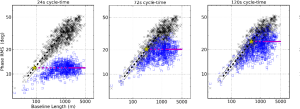The ESO internal ALMA development study "ESO-ALLEGRO Phase RMS database" officially started in July 2021. Since site testing studies conducted over two-decades ago there have been no statistical studies, nor material presented to explore the atmospheric variations (phase RMS) of the thousands of accrued ALMA observations. The Phase RMS study will remedy this.
New development study exploring atmospheric variations

Understanding and counteracting atmospheric variations is fundamental for interferometric synthesis arrays. At Chajnantor there are indications of diurnal variations or monthly changes in atmospheric stability found from these historic data, more recent, smaller, stand-alone Extension and Optimisation of Capabilities (EOC) tests, and Quality-Assurance (QA) data, however a long-term dedicated study is still lacking.
The ESO-Allegro Phase RMS database study will reanalyse the bright point sources, bandpass calibrators, in all ALMA PI observations taken since Cycle 3 in order to better understand how the phase RMS varies as a function of timescale: seconds to minutes, relevant to individual observations; and over months and years for a wholistic view. We will also establish these values as a function of baseline length throughout the cycles. The study will deliver a new ALMA memo and provide a public access phase RMS database which will have a continuing positive impact on future observing strategies, the optimisation of scheduling, and QA.
Detail on the figure reported above: Using data from a pilot study the Phase RMS has been calculated as a function of baseline length for the total target scan time (5min) as shown by black crosses in all panels, and for timescales of 24s, 75s and 120s respectively, show as blue squares in the panels left to right. The plots illustrate that over a 5min timescale, the longest baselines can have phase RMS values up to 50deg which could cause coherence losses of about 30%, i.e. the peak flux of an image with 50deg phase RMS will be reduced due to phase noise. Measuring the phase RMS on different time-scales (24, 72, 120s left to right) shows how the shorter times have a reduced phase RMS. Measuring over these different timescales, as we will do for the study, is representative of using a observation sequences with different cycle times (the time to start a phase calibrator scan, observe the target and return to the next phase calibrator scan) and indicates that in some situations, e.g. classically poor weather stability, that faster cycle times could provide a better correction of phase fluctuations, or that faster cycle times for a given weather condition can allow a higher observing frequency to be use.

